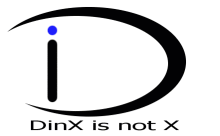

This is a work in progress, so please expect problems and shortcomings. I appreciate all success/failure stories, bug reports, fixes, suggestions, comments, job offers, etc. Feel free to contact me at the address below.
DinX is most certainly not X. X acheives performance by using huge gobs of code and memory to buffer requests and reduce the number of context switches. It is a gigantic piece of code with a very complicated API. It is also capable of running many many existing programs across a network of machines with different word sizes and byte orderings. It has almost as many window managers as entry points, and enough documentation to sink a small fleet. For all these reasons, DinX is not X.
The latest release of DinX is always available on the download page.
Drawing in DinX is done without context switches. The kernel module contains just enough logic to clip a drawing operation to any windows that might be obscuring it, and to draw what's left to the framebuffer. It also sends redraw events to windows that need to clean up after some part of the window that was obscured becomes visible again. Everything else, like events, window management, palette configuration etc, is handled by the server process. The kernel module passes through messages between the client windows and the server.
dinx-announce list is low volume, read-only, and carries
annoucements of new DinX releases. The dinx-general list is
unmoderated and carries general discussion of DinX design, code, features,
bugs, and everything else.
To subscribe to
dinx-announce send mail to
dinx-announce-request@lists.sourceforge.net with the word
subscribe in the body.
To subscribe to
dinx-general send mail to
dinx-general-request@lists.sourceforge.net with the word
subscribe in the body.
There are lots of other things that need doing too. If you find DinX useful and want to contribute, speak up on the mailing list so we can roll your improvements into the next release.
The DinX sources are licensed under the MPL with GPL option. If you make a change that you wish only to be used under the GPL, please say so when submitting it. Otherwise we'll assume it may be used under the MPL. Changes that are restricted to GPL use might not be accepted.